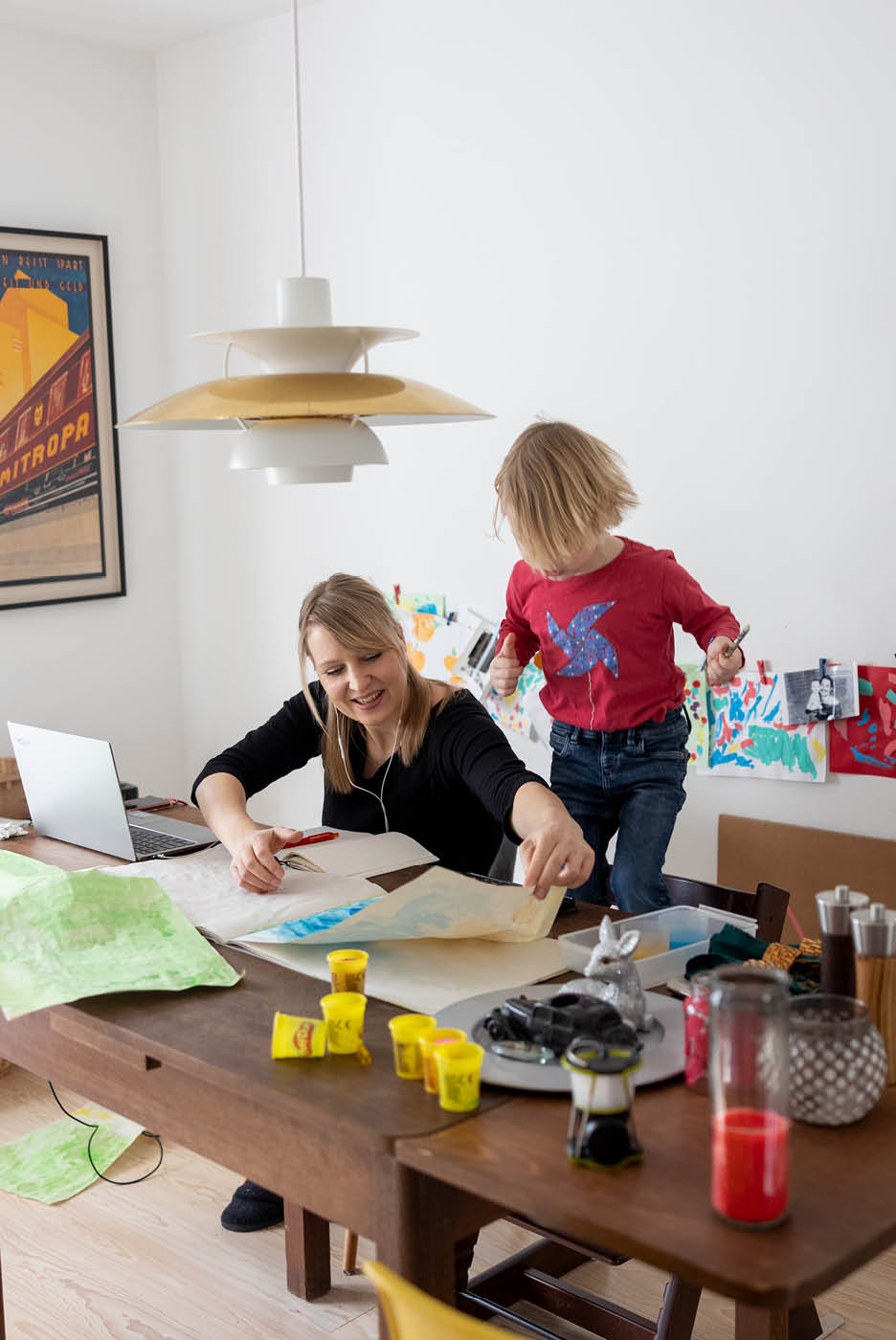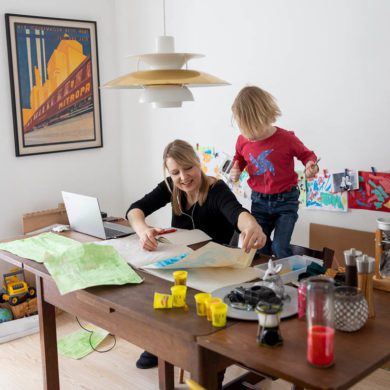Most of us have a collection of alarming stories about remote work during the pandemic. They range from the amusing – in my case, a team of children commando-crawling into the office during a zoom call – to the totally unacceptable.
Say, for example, that time a manager emailed her employee in the middle of the night demanding a piece of client work for 9am the next morning.
“That was a real low point for me,” says Ellie Pietsch, a 40-year-old mum from Melbourne, as she relates this particular horror story. “I was actually awake with my baby at the time and my initial reaction was panic, followed by anger. How on earth could they have thought this was a reasonable request? But it was the pandemic and normal rules did not apply.”
In fact, it’s true to say there have been few periods in recent history where the world of work has been so comprehensively upended. In the space of two years, remote work shifted from a minority activity, where only 2 per cent of total hours were worked from home, to a situation where up to 40 per cent of Australian workers were dialling in from their hastily-arranged “home office”. Suddenly, the demarcation between work and home disappeared, and no-one knew exactly how to manage the new order.

In her colleague’s defence, adds Pietsch, she was under significant pressure to meet company goals. It’s easy to forget that back in 2020, experts were predicting the dire effects of the global economic contraction, which Australia has since managed largely to avoid.
“She was feeling the pressure to perform, which was tough, but I still felt taken advantage of,” says Pietsch. “I said I couldn’t get the work done in such a short timeframe, but I wonder if another, younger employee might have felt they’d be blacklisted if they didn’t say yes.”
A false start
There are, of course, many advantages to working from home, not least the lack of commuting time (pre-pandemic, the average Australian spent over an hour commuting every day). During lockdowns, productivity remained stable and employers’ eyes widened at the prospect of giving up the leases on expensive inner-city office space.
As a result, many of them are tentatively embracing the work-from-home shift, which is lucky as studies show most workers now want to work from home at least some of the week.
But Pietsch’s experience highlights one of the main dangers of remote work: in creating an “always-on” culture, we run the risk of placing unreasonable demands on employees, which can rapidly lead to burnout.
This problem seems to be particularly acute in Australia, which recorded the highest rate of burnout in a recent survey of nearly 15,000 workers in 25 countries.
Most workers want to work from home, at least some of the time
The good news is, it doesn’t have to be this way.
In their book, Out of Office, released last month, Charlie Warzel and Anne Helen Petersen argue that what we experienced during lockdown wasn’t really remote work at all.
“You weren’t working from home. You were labouring in confinement and under duress,” they write. “You were frantically tapping out an email while trying to make lunch and supervise distance learning. You were stuck alone in a cramped apartment for weeks, unable to see friends or family, exhausted, and managing a level of stress you didn’t know was possible. Work became life, and life became work.”
Now that we’re entering post-pandemic life, they argue, we have the opportunity to experience remote or hybrid working as it should be: a way of working productively and effectively at a time and place of our choosing.
Certainly that’s what Thankyou co-founder Daniel Flynn had in mind when he and co-founder Justine introduced a “work from anywhere” policy back in March 2020 (coincidentally, just as lockdowns started).
Previously a self-described Office Guy (“I was 100 per cent about the office vibe, the office culture”), Flynn’s perspective changed when he and wife Justine moved from Melbourne to New Zealand to drive the launch Thankyou’s body-care products.

“Obviously, I was super-sceptical about working remotely, but it was incredible,” he says now, from his new home in the Gold Coast. “I stepped out of the bubble we’d built and it was hard to unsee the inefficiencies and challenges. Now, our team can choose to work remotely from home, or at a shared office space, and we’ve introduced touchpoints through the week and month that build culture and community.
“We’re not perfect,” he adds, “but we’re more productive than we’ve been in the last five years.”
So how do you make remote work, work?
“Fundamentally, companies need to understand the conditions that are required to get the work done,” says Associate Professor Ruchi Sinha, an organisational psychologist at the University of South Australia.
When employees are working in the same physical place, this is easier to discern. But in a remote or hybrid environment, leaders need to be a lot more intentional.
“If your teams are required to work collaboratively, you might need to accommodate that with more meetings, either in-office or on zoom,” says Sinha. “But employees also need time for deep work, where they’re immersed in a flow state that makes them both effective and happier.
“Constant interruptions – whether from children or emails – reduce that flow, and can lead to burnout.”
That’s exactly what Catherine Dix, Head of Digital Consulting at Webprofits, saw in her colleagues last August, as they slogged through yet another lockdown. “Everyone was so tired, but they weren’t switching off, and neither were clients. We have employees in the US, Romania and the Philippines. You know, if you answer an email at 10pm, someone is going to email you back.”
So Dix started collating what she calls a ‘remote work playbook’, with guidelines that empowered employees to place parameters on work.

“For example, we ask people to manage their calendar so that, rather than asking someone if they’re available, it shows on Slack if they’re busy, or in meetings, or away. So people know that they’re not responsive at that time. And we ask people to turn off notifications when they’re not working, so when they finish work they’re not being reminded of it.”
These parameters or ‘guardrails’, as Warzel and Petersen term them, are designed with the understanding that we need protection. Not just from ourselves and our twitchy need to log on even when we’re meant to be offline, but from the pressure we might feel from managers, however subconsciously conveyed, to be always available. “Clear rules, implemented fairly, become guardrails: not just to hold people accountable or penalise, but structural components of the company culture,” they say.
On the flipside, employees also need to exercise self-discipline, says Sinha: “It’s a good idea to create what we call attachment and detachment rituals in your workday.
“Every day, after organising my family, I make a cup of coffee and only then open my computer. I end my day by taking the dog for a walk. These transitional moments help you to set boundaries around work .”
Why not everyone needs to be present All. The. Time.
If you’ve sat through hours of consecutive zoom calls, or received email chains as long as novels, asynchronous working may well change your life.
Put simply, it’s the idea that team members work together to move projects forward according to their own schedule, rather than cramming all communications into a ‘normal’ workday. You might work school hours, then jump into a project for a couple more hours once the children are in bed; your colleague might work from 5am til 11am, then clock off until evening.
“Asynchronous working really is the next frontier of flexibility,” remote expert Tammy Bjelland argued in a recent interview on The Remote Show podcast. “If we are tied to our desks from 9am to 5pm, that’s not true flexibility. Asynch enables each individual to get the work done when it works best for them.”
In order to do this, teams need to differentiate between work that requires communication in real time (‘synchronous’ work, like a meeting or zoom call) and work that can cope with a delay (‘asynchronous’). Sharing information or updates can be asynchronous; resolving conflict is best done synchronously, face-to-face.
Asynchronous working is the next frontier of flexibility
Technology is crucial in bringing about a truly flexible way of working, particularly for millennials and Gen Z, who often have very strong views on the platforms they prefer to use. Slack and Asana are popular; at Webprofits, team members even supplement written communications with short Loom videos to brief colleagues and clients.
“The feedback is that the more people work asynchronously, the more they like it,” says Dix.
But what about company culture?
One of the most commonly-made arguments against remote work centres on company culture – namely, the supposed difficulty of innovating when you lose those “water cooler moments”.
Somewhat surprisingly, Thankyou’s Flynn is ambivalent about these moments, particularly since flipping the switch to remote work. “There’s an interesting tension between the potential of these unforced “water cooler” interactions and adding unnecessary distractions into your day,” he observes.
That said, Thankyou ensures there are plenty of moments for interaction, with team catch-ups on Monday, Wednesday and Friday, via zoom. The leadership team catches up every day.
“On Monday mornings, we share news before each employee is matched randomly with another for a one-on-one zoom chat,” says Flynn, who compares it to arriving early to a meeting and chatting with the person you find yourself next to.
On Friday afternoons, the team gathers for a gratitude moment, where “we honour each other for different things we’ve done throughout the week. It can get emotional.”
Each employee is matched randomly with another for a one-on-one zoom chat
Flynn believes that remote working tests the fundamentals of a business, in terms of both culture and leadership. “If your team is hybrid, you have to have a compelling vision and values that people want to give their best to. So I think there’s a huge challenge for business leaders and founders to ask, ‘Are you hiring right? Is the vision, role and job description right?’ I look at our team, and there’s that fire.”
Really, how do you want to live?
“Thanks to the pandemic, everyone aged 25 to 65 has had a mid-life crisis,” says Sinha. “People are re-evaluating where they want to be and what they need to do to find fit at work.” That’s why the US has seen The Great Resignation (last November, a record 4.5 million people quit their jobs), and here in Australia we’re seeing what Treasurer Josh Frydenberg is calling “The Great Reshuffle”.
For Flynn, hybrid working has meant he can spend more time with his young family. “I thought I was around for the first year of my eldest child, but I was not – I was on a plane all the time,” he confesses. “Now, it just feels like a different life. I have time to rest, exercise and do some of the stuff I’ve always wanted to do.”
Pietsch has since left her corporate job to join Leading Teams, a company that – somewhat ironically – helps educate leaders in how they can build high-functioning teams. “I wanted to find work in a business whose values whose values aligned closely with my own,” she says.
As Warzel and Petersen say in Out of Office, the future of work isn’t just about the work. It’s about how work fits into your life and values, and what you might do with the flexibility that remote work brings. If you had more time, if you weren’t on 10 hours of zoom calls each day or chained to your inbox, what else could you achieve? How would you choose to live?














No Comments